The history of San Francisco’s most iconic music venues
SF Weekly (Cover Story)
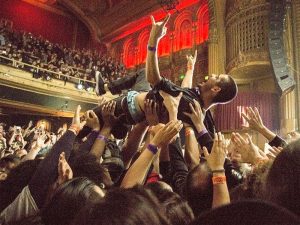 From techno warehouses to indie-rock taverns, San Francisco has no shortage of music venues. We’re especially lucky to have a few that are over a century old, having weathered fires, multiple owners, and at least one earthquake.
From techno warehouses to indie-rock taverns, San Francisco has no shortage of music venues. We’re especially lucky to have a few that are over a century old, having weathered fires, multiple owners, and at least one earthquake.
But if you’ve visited any of these spaces, a few questions have probably popped up (aside from “How much are the drinks?” and “When does the headliner come on?”). You might have wondered why The Fillmore gives away free apples or why there’s a window behind the stage at Bottom of the Hill. Perhaps you wanted to know why there’s a balcony above the stage at Great American Music Hall that never gets used. Or maybe you were curious about Social Hall, the music venue below the Regency Ballroom that looks like a mid-century school auditorium.
Well, today’s the day that those questions get answered! From top to bottom, we scoured five of San Francisco’s oldest music venues — The Warfield Theater, Regency Ballroom, The Fillmore, Great American Music Hall, and Bottom of the Hill — and uncovered forgotten histories, discarded relics, crumbling wall paintings, and secrets up the wazoo.
Check out our stories on each venue if only so that you can brag to your friends the next time you see a show. “Notice the rounded walls and railings around The Fillmore?” you can say. “That’s from when it was a roller rink in the ’40s.” Your friends will think you’re really cool. You’re welcome.
The Regency Ballroom
Thrones, trap doors, and double-headed phoenixes.
 Viewed from outside, the Regency Center, in which the Regency Ballroom is located, looks like a droll, white Beaux Arts building on the corner of Sutter Street and Van Ness Avenue. But from within, the five-story, 108-year-old structure houses many secrets and delights — like trap doors, Tiffany glass windows, and hand-cranked elevators — which most concert attendees will never see.
Viewed from outside, the Regency Center, in which the Regency Ballroom is located, looks like a droll, white Beaux Arts building on the corner of Sutter Street and Van Ness Avenue. But from within, the five-story, 108-year-old structure houses many secrets and delights — like trap doors, Tiffany glass windows, and hand-cranked elevators — which most concert attendees will never see.
After two years of nonstop construction, the Regency Center opened its doors in 1909, and until 1911 — when the now-defunct Avalon Ballroom was built — it was the only building on that block of Sutter Street. Like the Avalon, which opened as a dance school called the Colin Traver Academy of Dance, the Regency Center was not intended as a concert hall.
Built and owned by the Scottish Rite Freemasons as a lodge, it housed the fraternal organization’s auditorium, cafeteria, throne room, offices, and library. The attic, located on the unofficial sixth floor and accessed by a steep, winding staircase, served as the Freemason’s robe room, and the wooden lockers, which resemble Catholic confessionals, are still there today. So, too, is the building’s original manual elevator, which received a new motor last February. The upper floors consist of a maze of rooms, some of which were used for playing billiards or for sleeping overnight, as evidenced by the Murphy beds built into the walls. There was even an entire floor that was off-limits to women, lacking even a women’s restroom.
The auditorium where the Ballroom is located was always used as a performance space, its mezzanine level rimmed with seats, just as it is today. Back when the Freemasons occupied it, however, most of the events consisted of formal dances, and the lion heads and double-headed phoenixes embedded in the molding were meant to symbolize rebirth and metamorphosis.
Off-limits to most guests is the lodge itself, a large, rectangular room coated entirely in red cloth and crowned by a modest stage. The lodge was where the Freemasons kept their red velvet thrones, which are still scattered around the venue. Hanging chandeliers and torch lighting illuminate the space, which is now rented out for events, such as weddings and bat mitzvahs. The stage itself is equipped with 32 hand-painted backdrops depicting a litany of themes, like heaven, hell, and paradise, each coinciding with a certain rank and level within the organization. The hand-pulley system for lowering the backdrops still functions today, and one of the panels, consisting of paintings of demons and devils, was used as background art for country-rock singer Hank Williams III’s seventh album, Ghost to Ghost.
The original pipe organ in the lodge also still works and is played on a weekly basis to keep it in shape. Around 2011, when Williams and Tom Waits played a show at the Regency Ballroom, the musicians became enamored with the organ and took selfies in its bellows.
In one corner, close to the throne room, is one of the Regency’s better-kept secrets: a trap door. Now hidden under a blue rug, the rectangular hole in the floor was used as an initiation rite for Freemason members. The inductee would have a noose placed around his neck and was required to jump through the door to the floor below — at least a 20 foot drop — where he would be caught by other members.
Although the Freemasons continued using parts of the Regency until the 1980s, they sold it in 1966 to a corporation that turned the ballroom into an 800-seat movie theater. At some point during the movie theater’s 40-year existence, the entire ballroom was coated in white paint, while other areas were given baby-blue makeovers. In the 1980s, the Polish Arts and Culture Foundation used parts of the building as a dance studio and banquet hall.
By the turn of the millennium, both the movie theater and dance studio had closed, and the space had become a booking venue for corporate events, weddings, and trade shows. In 2008, when the Warfield Theater closed for renovations, its concerts were diverted to the Regency Ballroom, and Goldenvoice, the Warfield’s promoters, began renting the center soon thereafter.
It’s now been eight years since Goldenvoice turned the Regency Ballroom into a concert hall, and though hip-hop artists like Chance the Rapper, Migos, and Lil B, dominate the schedule, other acts, like Flight Facilities and Bad Religion, have graced its stage, too. Christopher Owens, of the former S.F. indie-rock band Girls, recorded a live album at the Regency, and even Hillary Clinton made an appearance for a DNC fundraiser. The street artist Banksy also drew one of his iconic “glitter rats” on the backstage door, although that has sadly been removed.
The most recent development was the opening of the building’s basement concert space, Social Hall, in fall 2015. Once the cafeteria for the Freemasons, the space is now one of the best venues in the city to see intimate, live shows with great acoustics, and everyone from David Duchovny and Vince Staples to Sevyn Streeter and Brazilian Girls have played there. The cafeteria’s original stage and wood flooring remains intact, but the hanging light fixtures have been replaced with plastic replicas, and its mammoth, industrial kitchen is now no longer used.
Much of the building has also been updated. The ballroom is now no longer monochrome and the original gold and woodwork has been painstakingly hand-restored. The chairs left over from the venue’s movie theater days have been replaced with comfier, maroon seating, and the former gas lighting fixtures have been updated. Some floors didn’t even have running water in the bathrooms, a hindrance that has since been fixed.
Bottom of the Hill
‘Gigging alone at the Bottom of the Hill.’
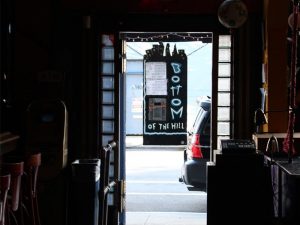 Square-shaped and peering out to the venue’s shrub- and succulent-filled patio, the window behind Bottom of the Hill’s stage is hard to miss. Framed by soft, yellow tea lights, it reminds me of the empty gold frame surrounding the peephole to Monica’s apartment in Friends. Then again, a lot of things about Bottom of the Hill remind me of the ’90s — which makes sense, because that’s when the venue opened.
Square-shaped and peering out to the venue’s shrub- and succulent-filled patio, the window behind Bottom of the Hill’s stage is hard to miss. Framed by soft, yellow tea lights, it reminds me of the empty gold frame surrounding the peephole to Monica’s apartment in Friends. Then again, a lot of things about Bottom of the Hill remind me of the ’90s — which makes sense, because that’s when the venue opened.
The building, which was built into bedrock at the foot of Potrero Hill, was not originally meant to house concerts. Historical records show that the light-blue, two-story Edwardian was opened in 1911 as a saloon and eatery called 17th Street Restaurant. For the first few decades of the 20th century, Potrero Hill was home to a growing population of Italians and working-class families who found employment at nearby shipyards and warehouses. Aside from houses, little existed in the area, so the restaurant and bar was always packed, cycling through hundreds of customers each meal.
In the 1930s, the restaurant was turned into a soda fountain, and Bottom of the Hill’s current owners suspect it was also used as a speakeasy during Prohibition. For 20 years, it was a family-owned restaurant, before business fell off in the 1980s when many of the local shipyards and piers closed.
Though ownership changed hands a few times, it continued to operate as a restaurant, even after Tim Benetti purchased it around 1990. There was a twist to his plan. The venue, officially renamed Bottom of the Hill in 1991, still served three meals a day, but Benetti wanted to make better use of its entertainment license. A music fan, he started booking local punk and rock acts to play shows and exhibit art on the walls. Over time, the musical acts started attracting more people than the restaurant, and breakfast and dinner were soon phased out.
With this change of focus, a renovation was required to make the space suitable for live shows. The restaurant’s original, supremely long bar was shortened a few feet to make way for new restrooms. The back wall was jackhammered to create space for a larger stage, and the interior walls were rebuilt to look curvy and crooked. Booths and neon lighting were added in the back room (though the Fire Marshal has since removed the neon), and so, too, was Bottom of the Hill’s pricey, yet infamous blue neon sign.
But it’s the acts that Bottom of the Hill was able to book that really put it on the map — as well as its inclusion in the lyrics to a song by NOFX. Because of its small size, it was viewed as a great starting point for up-and-coming rock, grunge, and indie bands, and Bottom of the Hill managed to book acts like Oasis, Alanis Morissette, Marilyn Manson, and Elliott Smith in their early days. A riot broke out in 1996 when a radio DJ spilled the beans that the Beastie Boys were performing a secret show that night under the name Quasar, and Green Day filmed a live show for MTV called Live at the 10-Spot there. In fact, for a good portion of the ’90s, one of the upstairs apartments was turned into a recording studio so that Bottom of the Hill could record and livestream its shows.
By the millennium, nascent indie darlings like Neutral Milk Hotel, Arcade Fire, and The White Stripes were playing at Bottom of the Hill, along with wild card acts like Kid Rock. A fire wreaked havoc on the building’s upper floor office in 2003, putting an end to the venue’s recording and livestreaming efforts.
The main change to the building has been the gradual but steady construction of a gray condominium behind the venue. Though the lot next door to Bottom of the Hill has been empty since its opening, the lot behind it was sold around 15 years ago to a developer. For years nothing happened, until workers arrived in 2015 and started building. Now more than half-finished, the condo is estimated to open by the end of this year. Here’s hoping the people who move in don’t mind loud music.
The Warfield
Bullet holes, Anna Nicole’s lips, and (allegedly) a tunnel built by Al Capone.
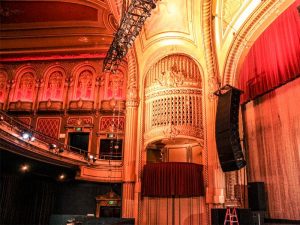 Opened in 1922 as a vaudeville theater called the Loews Warfield, the Warfield was for a long time cluttered with rows of seating that made contemporary concert necessities like moshing and dancing nearly impossible.
Opened in 1922 as a vaudeville theater called the Loews Warfield, the Warfield was for a long time cluttered with rows of seating that made contemporary concert necessities like moshing and dancing nearly impossible.
This wasn’t a problem during its first five decades of operation, when the goal was to fit as many people as possible into the gold-and-red theater on Market Street. Old movie stars like Buster Keaton and Clara Bow graced the stage, along with dancers, comedians, magicians, and — in 1931 — a guy dressed in a Mickey Mouse costume.
But though the venue has cycled through various names and promoters over the years, no change was as pivotal as when the seats were removed from the front of the stage. Rumor has it that Joe Strummer of The Clash once refused to play at the venue unless the first two rows were removed, but it’s unclear whether that was actually Strummer’s request or the dawning popularity of the venue as a concert space that led to the seats’ eventual removal.
One of the first musical acts to book a show at the Warfield was Bob Dylan, who played 14 shows in 1979 at the start of his first Gospel Tour, and another 12 in 1980. Because it can house more than 2,000 people, the venue became a popular hub for rock acts, and the Grateful Dead — as well as Jerry Garcia when he went solo — played dozens of shows there for a number of years.
Rock dominated the Warfield’s lineup for another decade or two — and continues to today, with acts like Stone Temple Pilots, Korn, The Killers, and Jane’s Addiction stopping by the Warfield when they’re on tour. Thrash-metal band Slayer recorded a music video there in 2001, and Green Day performed the entirety of American Idiot in October 2005.
Goldenvoice took over management of the theater in 2008, and since then, the venue’s lineup has become more diverse. Acts like Erykah Badu, Young Thug, Duke Dumont, and B.B. King have all made the bill, and Kanye West once played a medley of old and new hits at a DNC fundraiser for President Barack Obama in 2015.
Aside from the chairs and the acts, though, little else has changed about the Warfield. The celestial angel paintings are still on the ceiling, and the Greco-Roman busts still line the upper walls. The wooden telephone closets still exist, although they’re now empty, and you can still see tracings of the ironwork that lifted elephants from below the stage.
The venue’s most interesting gems, however, can be found underground. That’s where the green rooms, dressing rooms, and offices are, and there’s even a six-story spiral staircase that extends to the roof. Al Capone was believed to have run a speakeasy in an area of the basement that now houses debris, generators, and odds-and-ends. You can still see paintings from that era depicting exotic women, palm trees, and camels, but the tunnel that purportedly connected Capone’s speakeasy to others throughout the city has yet to be found.
When BART was constructed in the 1960s, the venue’s subterranean space was diminished to make way for tracks and planters for trees, and neon paintings from the era when Bill Graham himself ran the venue can still be found on the walls. There are also bullet holes in one wall that date from a party in the ’80s when a guard let attendees fire his gun for fun.
But by the far coolest attraction at the Warfield is the autograph room. A narrow space located next door to the green room that used to be Jerry Garcia’s, it is covered entirely with signatures and drawings by the hundreds of artists who have played at the Warfield. Obama’s signature is close to Kanye’s, which also includes the numbers “#46 2020,” a nod to his presidential ambitions. Nirvana, The Ramones, Mac DeMarco, and Kesha have signed it, too, and you can find a bevy of smeared lipstick kisses from the likes of Carmen Electra and Anna Nicole Smith.
Unfortunately, space is now at a premium on the room’s cluttered walls, but Goldenvoice says it is committed to keeping this tradition alive, even if that means taking out all of the furniture in the room.
The Fillmore
From roller rink to psych-rock mecca.
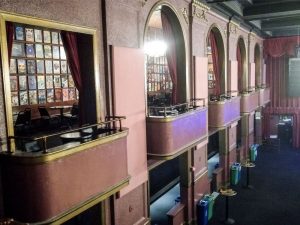 Before the Neoclassical brownstone building that is The Fillmore was built in 1912, the lot on the corner of Fillmore and Geary streets housed a Jewish temple called Beth Israel Synagogue. The 1906 earthquake destroyed it, and it was replaced with a sparkly new edifice designed by Reid & Reid, the same fraternal architecture firm that built the Cliff House and Fairmont Hotel.
Before the Neoclassical brownstone building that is The Fillmore was built in 1912, the lot on the corner of Fillmore and Geary streets housed a Jewish temple called Beth Israel Synagogue. The 1906 earthquake destroyed it, and it was replaced with a sparkly new edifice designed by Reid & Reid, the same fraternal architecture firm that built the Cliff House and Fairmont Hotel.
Dubbed The Majestic Ballroom, it was intended to be a society club with ballroom dancing and lessons for upper-crust denizens of San Francisco. Tickets cost 35 cents, but you could get 10 cents knocked off if you brought an extra lady, says Tony Biancalana, The Fillmore’s longest-working employee, who has found old relics from the Majestic era in the attic.
The building remained a dance hall until 1939, when it was turned into a roller rink called the Ambassador. You can still see vestiges of that time in the main ballroom’s curved walls (which helped reduce injuries) and the metal railings lining the entryways to the space adjacent to the ballroom.
The Ambassador was converted into a music venue in 1954, when concert promoter Charles Sullivan purchased it and renamed it The Fillmore Auditorium. At the time, Sullivan was one of the most successful Black businessmen in San Francisco and booked acts like Ike and Tina Turner, Little Richard, and young Jimi Hendrix.
In 1965, Bill Graham rented out The Fillmore to throw a party for the San Francisco Mime Troupe. The event was more successful than Graham imagined, Biancalana says, and earned the promoter a whopping $4,000.
For the next three years, Graham continued to rent the venue from Sullivan, slowly replacing the venue’s earlier rhythm-and-blues acts with more rock ’n’ roll. During that short period, many of the biggest musicians from the ’60s made tour stops at the Fillmore, including The Velvet Underground, Nico, The Doors, Santana, Led Zeppelin, The Byrds, Janis Joplin, and Jefferson Airplane.
Graham was also inventive with his parties — which might be why Hunter S. Thompson included a mention of The Fillmore in Fear and Loathing in Las Vegas. Graham paired differing acts on the same bill, like The Who with jazz clarinetist Woody Herman or the Grateful Dead with Miles Davis. He also introduced ambiance enhancers, like strobe lights, film projections, and freewheeling offstage dancers.
“This was the test model for the way that people now see rock ’n’ roll shows,” Biancalana says. “It was just this place you could go and hang out at, smoke weed, and not be messed with.”
The barrel of free red apples in the lobby of The Fillmore is also a relic from Graham’s days. It is believed that Graham, a Holocaust survivor, lived off apples for a period in his early life, Biancalana says. The apples could also be a relic from Graham’s time working at resorts in the Catskill Mountains, where baskets of fresh fruit and candy were commonplace.
In 1968, Graham opened his own location, Fillmore West, at the corner of South Van Ness Avenue near Market Street, and ceased throwing shows at the venue until 1985. During his absence, The Fillmore, yet again, was used for more than a few different purposes. For a while it was a mosque, which Biancalana says the building still gets mail for. In the early ’80s, it was turned into The Elite Club, a punk-rock venue that booked acts like Black Flag, the Dead Kennedys, Gang of Four, and Bad Religion.
Bert and Regina Kortz purchased the building in the mid-’80s and continued running the venue as a music space. They occasionally rented the space out to Graham, who threw sporadic shows there until his death in 1991.
After the Loma Prieta earthquake in 1989, the building was so damaged that it wasn’t functional. It remained closed until 1994, when The Smashing Pumpkins played an unannounced surprise show, and Primus played the next night for The Fillmore’s official reopening.
Since then many of the biggest acts to roll through San Francisco have made tour stops at The Fillmore, like Nick Cave and the Bad Seeds, No Doubt, Beach House, Radiohead, The Cure, and Prince.
For the last few years, Live Nation, which currently manages the venue, has been steadily renaming established clubs in cities like Detroit, Denver, Philadelphia, and Miami Beach to match The Fillmore’s name. So if you start noticing more and more venues around the country named The Fillmore, you’re not crazy.
The Great American Music Hall
Prostitutes, tax evasions, and the dotcom boom.
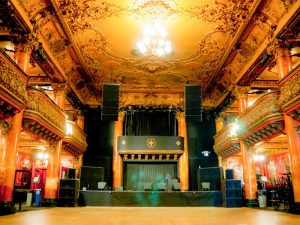 The Great American Music Hall has a long history of being what sound engineer Lee Brenkman calls “a fairly disreputable place.”
The Great American Music Hall has a long history of being what sound engineer Lee Brenkman calls “a fairly disreputable place.”
A crooked politician named Chris “Blind Boss” Buckley, who also owned the hotel next door, opened the venue in 1907. He named it Blanco’s after a notorious Barbary Coast bordello, and operated it as a gathering space for men looking to gamble, drink, hear live jazz, and hire prostitutes.
“It was a cafe for gentleman, which pretty much means the same thing as a gentleman’s club does now,” says Brenkman, who has worked at Great American since 1972. “If young gentlemen of means came in without a date, one could be provided and added to the check.”
In fact, in recent years, during a heavy-duty cleaning, wallpaper etchings of ancient women of Pompeii doing what Brenkman calls “the nasty” were found on the ceiling of an old smoking room.
The Hall’s next owner, Sally Rand, was as ribald as Buckley. A burlesque dancer made famous by her erotic feather and bubble routines, Rand renamed it the Music Box and performed her lascivious dances at the venue. Back then, the dance floor was recessed and there was a small platform elevated above the main stage with curved staircases on either end connecting to the floor. Rand would dance on top, the band would play on the main stage below her, and the chorus girls would fan out along the stairwells. There was also a secret lounge upstairs called the Blue Room, where you had to know someone to get in.
After World War II, the Hall changed hands a few times. For a while, it was a jazz venue called the Cotton Club that made what was then a groundbreaking decision to have a mixed-race house band. In the ’50s, it was a meeting house for the Loyal Order of Moose.
Things started to spice up in the ’60s, when a French restaurateur named Charles Robert bought the space. Already the owner of a restaurant near the Embarcadero that was named Charles, Robert had high ambitions for his second eatery, installing a wine cellar below ground and expanding the size of the kitchen to include a stove top big enough to make 50 gallons of soup stock at a time.
Robert was also intent on making his new restaurant as exclusive as possible. The business had an unlisted phone number, and you either had to personally know Robert or the head barman to make a reservation. Lamb, another focal point for Robert, was the only red meat on the menu.
“He believed that Americans didn’t eat enough lamb, and that they overcooked it when they did,” Brenkman says. “If you ordered it any other way than medium-rare, he’d throw you out.”
Robert’s reign ended when the government began investigating him for tax evasion, and he simply disappeared one day, never to return. The venue was shuttered, and eventually new owners bought it through an IRS auction. Years later, Brenkman says, the Feds finally caught up with Robert, who, at the time, was working as a dishwasher at a casino in Tahoe.
Like its previous owners, the Hall’s new owners wanted to run it as a jazz club, but the dwindling number of attendees who came soon forced them to broaden their musical scope. Folk singers and rock bands were added to the bill, and the venue was able to nab acts like Journey, B.B. King, and Van Morrison. Dozens of live albums were recorded there during that time, including the Grateful Dead’s One From the Vault. A young Robin Williams also made some of his earliest stand-up comedy appearances there. Brenkman recalls seeing a cheetah on a leash during a private party in the ’80s, and rabid concertgoers scaling fire escapes and breaking through the building’s skylight to get into what they believed was a secret Grateful Dead show. (It was not.)
After a lengthy divorce and roughly three decades of running the place, the owners sold the venue in 2000 to a music startup called Riffage.com for a purported seven-figure sum. Thanks to the dotcom boom and Riffage’s grandiose plans — which included starting a website, producing and streaming live shows, and forming a record label — the company ran through its money in a matter of months and went bankrupt.
Great American Music Hall wasn’t on the market for long. Although House of Blues came and looked at the property, it was Slim’s who eventually purchased it in 2002.
Today, its nefarious past is all but forgotten, and it is now a hub for indie outfits and singer-songwriters. Bands like The Black Lips, Arcade Fire, Bastille, and The Soft White Sixties have played there, as well as solo acts like FKA Twigs, Dev Hynes (of Blood Orange), and St. Vincent.
Other than that, little else has changed. The Blue Room is still there, although now it houses Slim’s offices, and the murals on the ceiling and the outdoor marquee are still in their original condition. In fact, if you look closely enough, you can even still see the blue Cs that Charles Robert painted in the corners of the ballroom, way back when.
